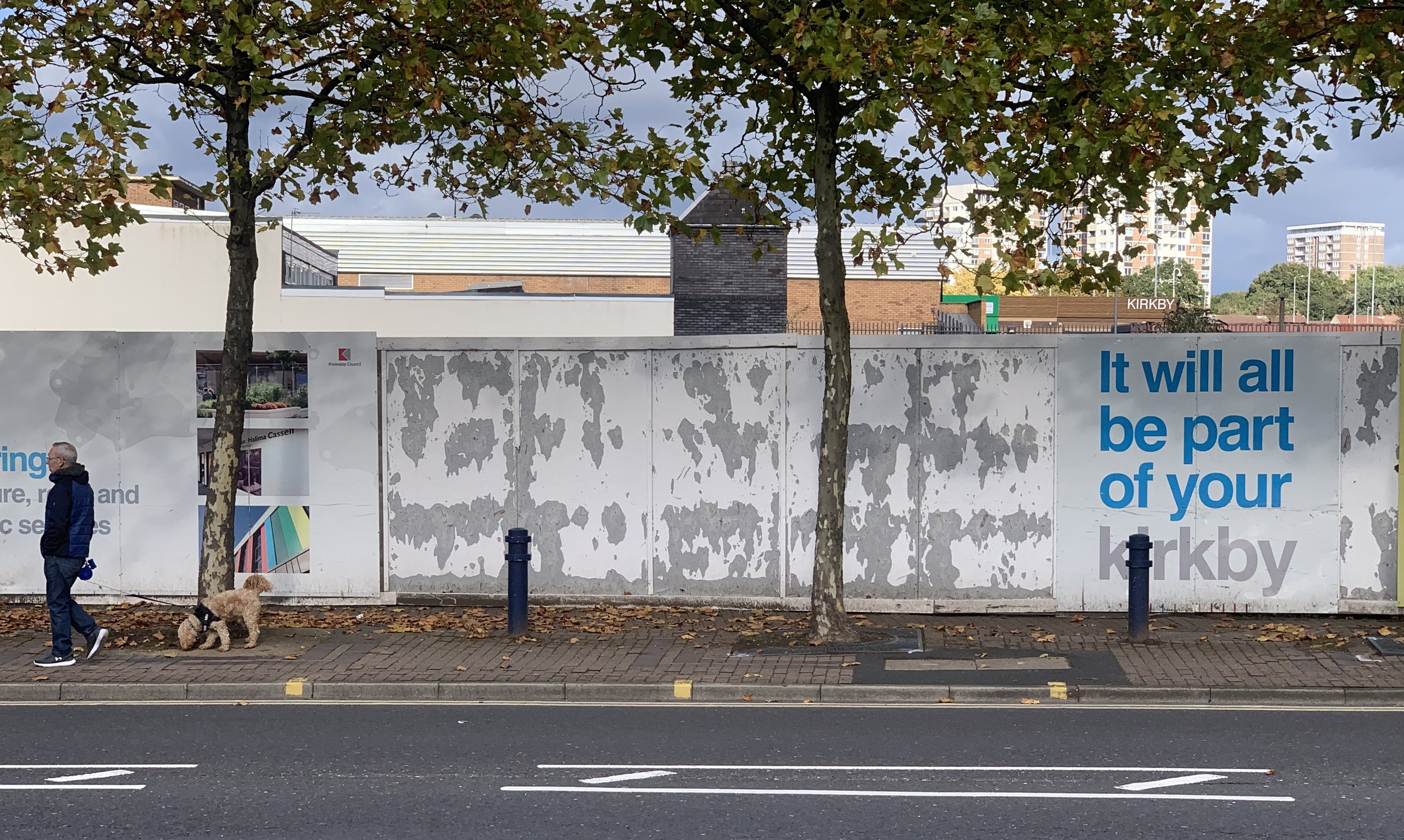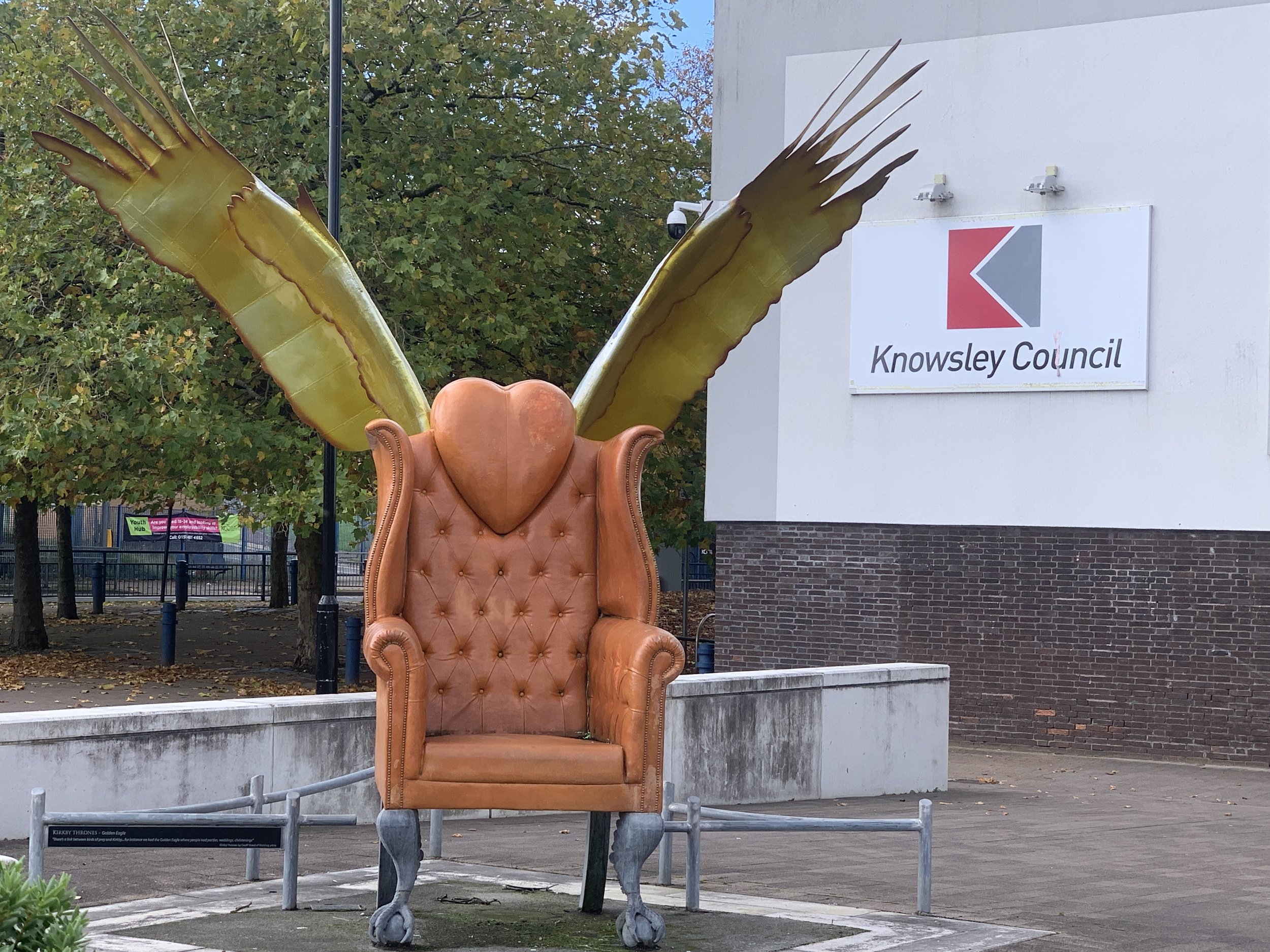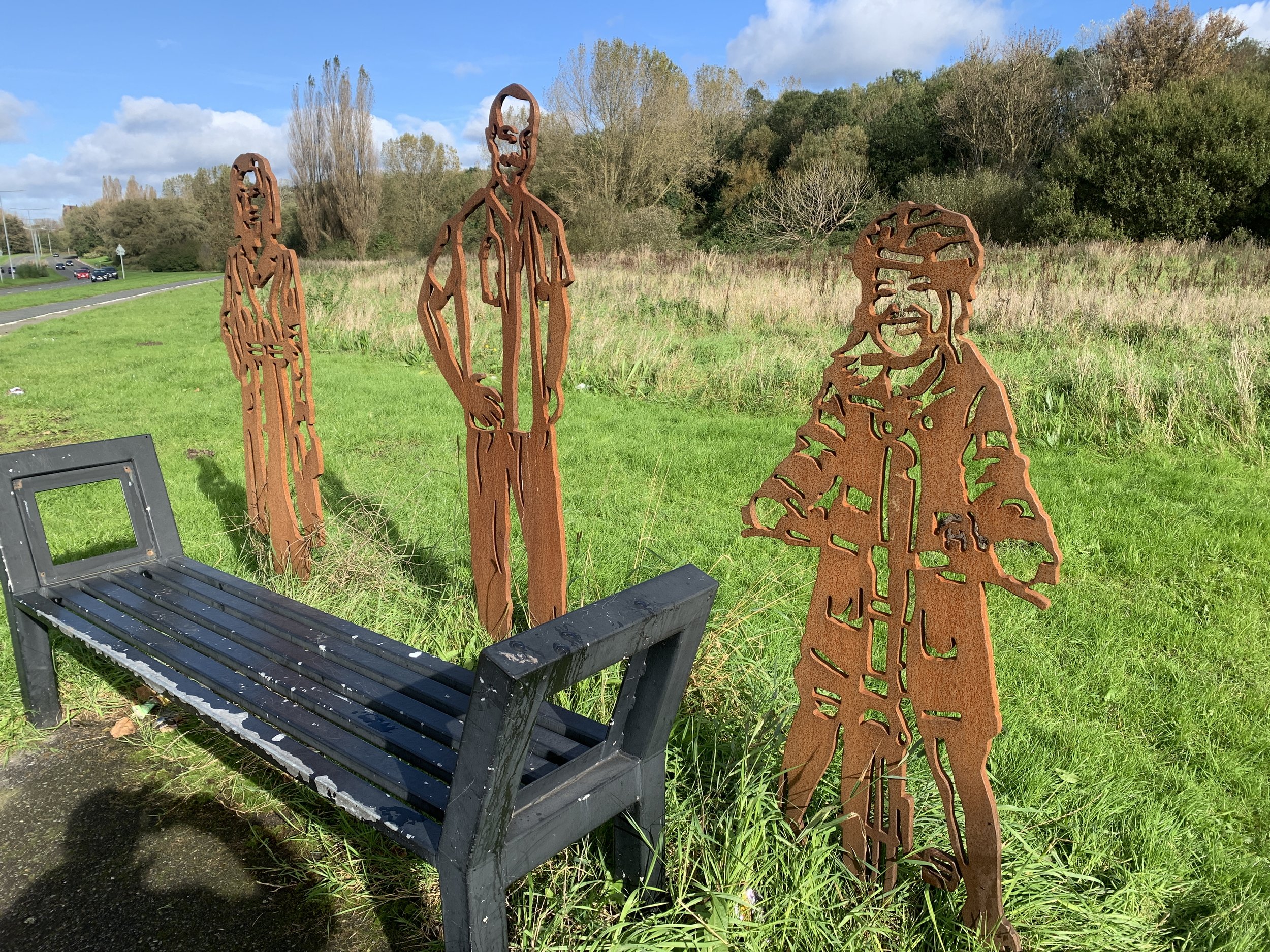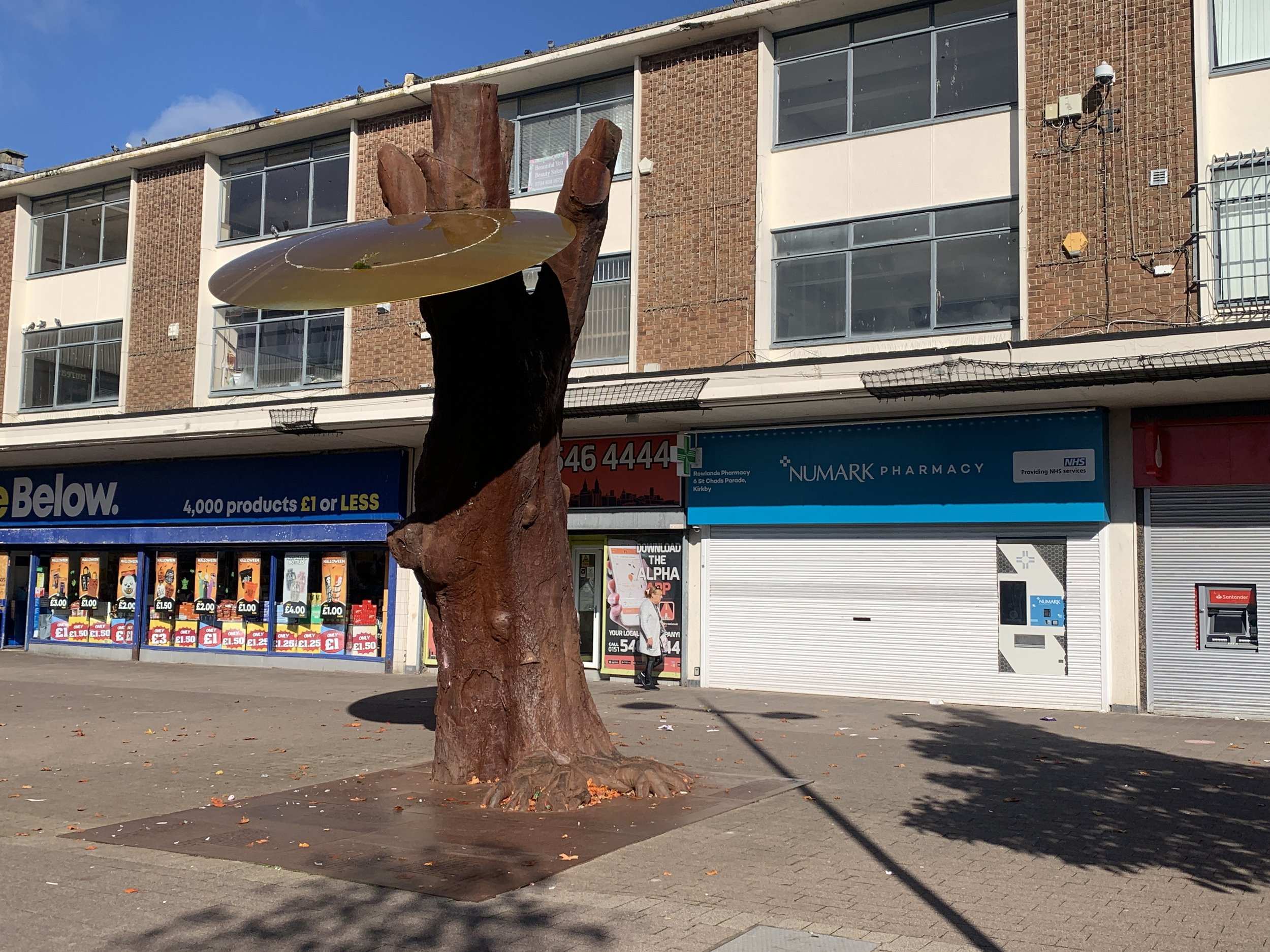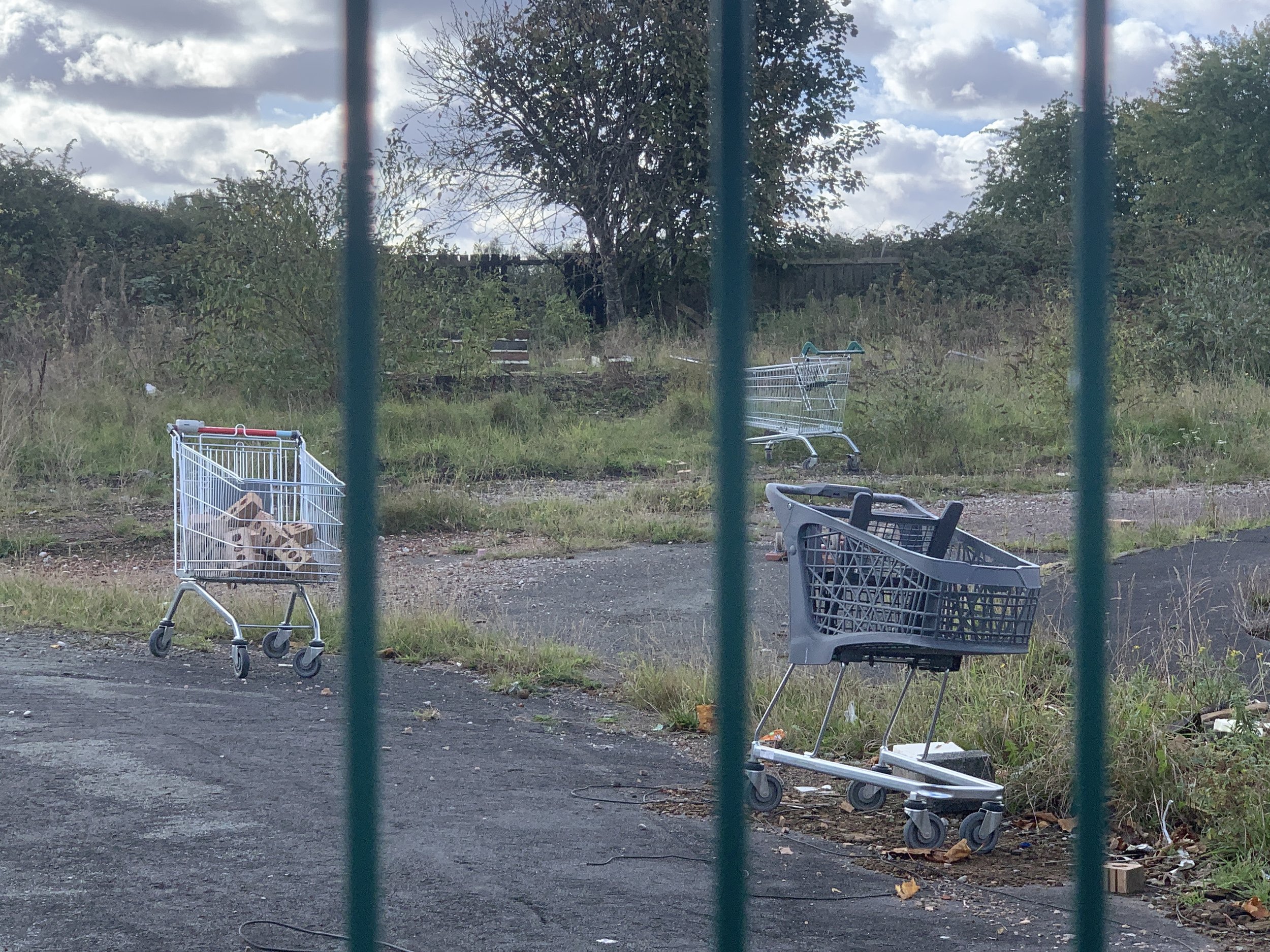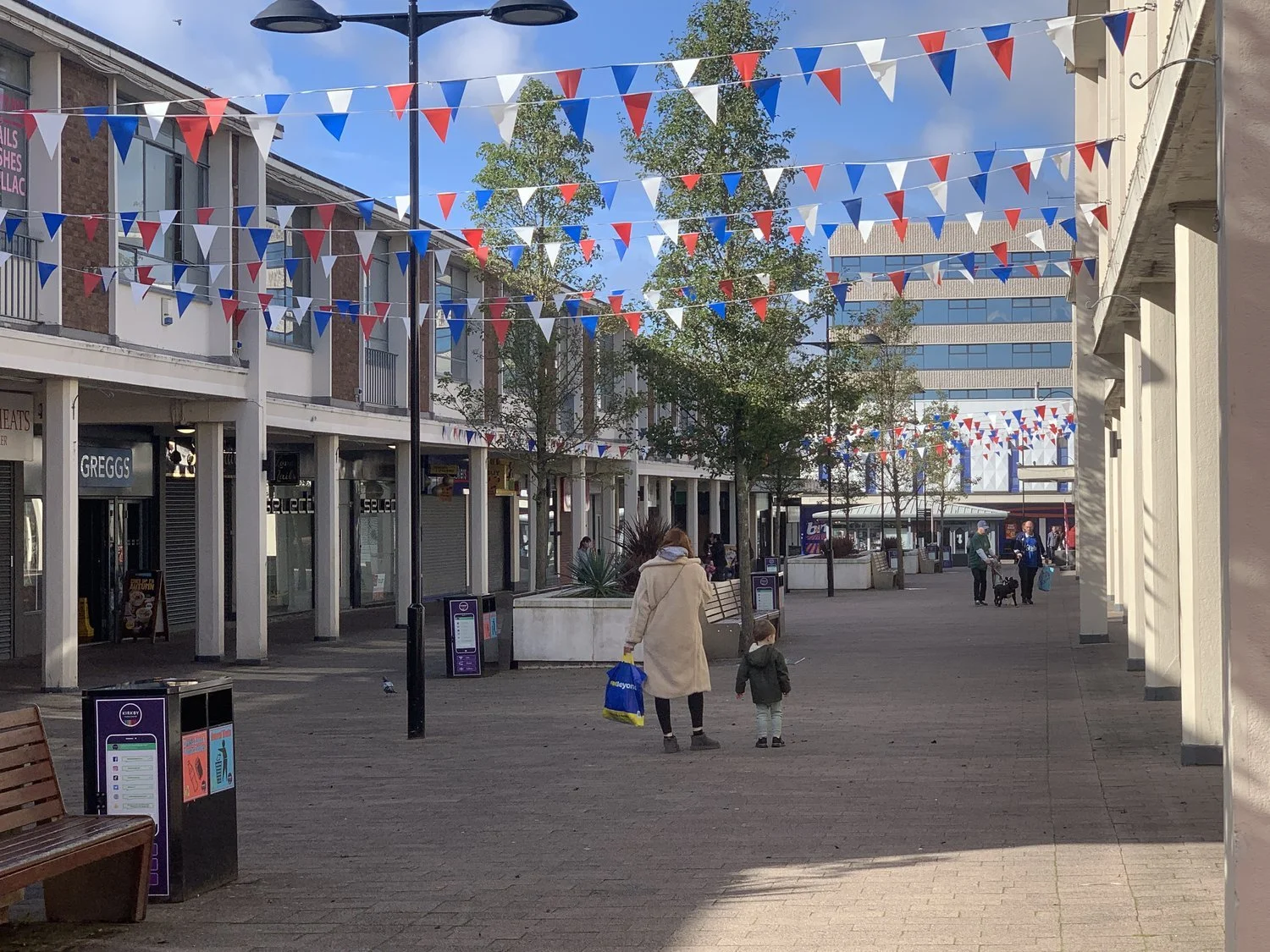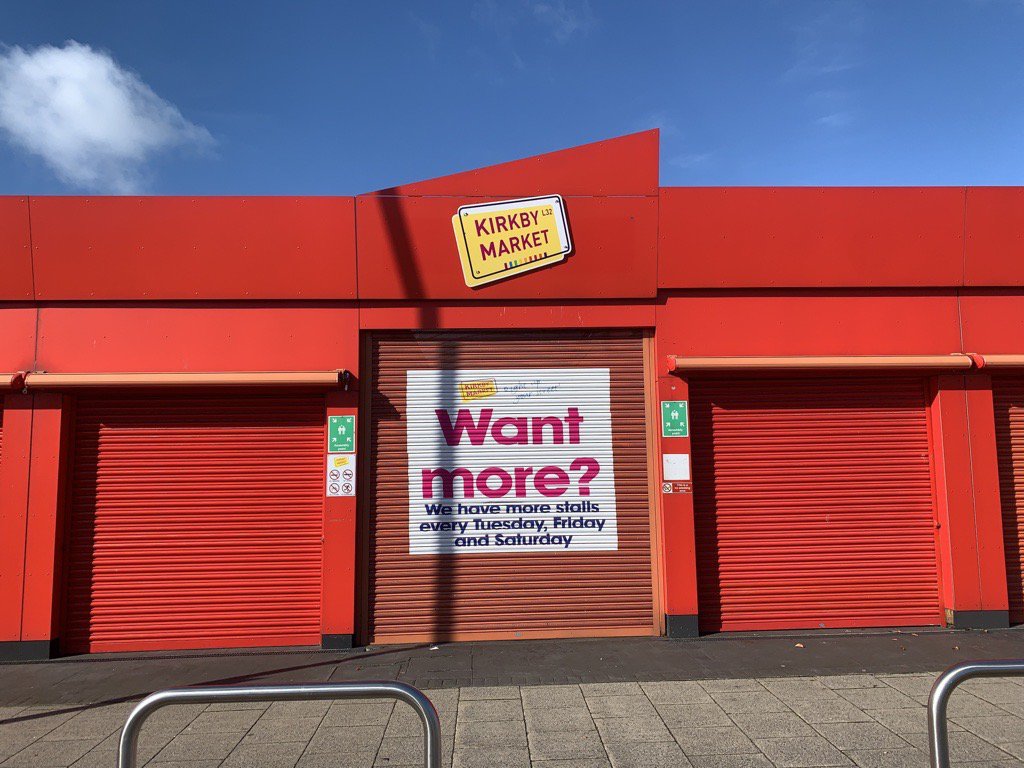Recent features
What next for the Wirral Waterfront?
As a child I found Wirral, and Birkenhead in particular, to be a deeply mystifying place. I knew that Ireland, where we went on holiday, was across the water, but where exactly was this other place? It wasn’t Liverpool, but was it even England or maybe Wales, or some strange liminal place existing outside my primitive geographical understanding?
Jon Egan
As a child I found Wirral, and Birkenhead in particular, to be a deeply mystifying place. I knew that Ireland, where we went on holiday, was across the water, but where exactly was this other place? It wasn’t Liverpool, but was it even England or maybe Wales, or some strange liminal place existing outside my primitive geographical understanding?
My earliest journeys across the Mersey did little to dispel Wirral's sense of disquieting otherness. The deep, dark descent into the underworld of the Mersey Tunnel only reinforced its obvious detachment from humdrum reality. This must be the other side of the looking glass.
Years later during my counter-cultural phase, and in the spirit of Parisian Surrealist explorations, we’d take “the metro” to Birkenhead in search of the merveilleux. Birkenhead’s numinous aura was only magnified by the eerie absence of people, the monumental grandeur of Hamilton Square echoing the ominous emptiness and abandonment of Giorgio de Chirico’s metaphysical city scapes.
In later years my associations with Birkenhead became more prosaic and practical through involvement in a succession of aborted regeneration initiatives and "visionary" but unrealised masterplans. Spending days talking to frustrated residents and world-weary stakeholders I was struck by their sad fatalism, as if the town had been subject to some strange and enervating enchantment. As Liverpool’s cityscape was magically transformed before their very eyes, Birkenhead seemed frozen in a state of suspended animation akin to Narnia trapped in its perpetual winter.
But of course there was nothing supernatural about the decline of Birkenhead. Once styled the City of The Future, Birkenhead has a proud and pioneering history. In addition to its global shipbuilding prowess, it’s the town that built the UK’s first public park, its first Municipal College of Art as well as Europe’s first tramway. Birkenhead’s curse is a toxic blend of economic decline and disastrous urban planning, making Birkenhead a place that’s easier to pass through than get to. Whilst cars, people and investment pass Birkenhead by, it’s tempting (and partially true) to point the finger at poor leadership and botched planning. But is there another more fundamental reason for the town’s baleful situation? Is it rooted in Birkenhead and Wirral’s deeper crisis of identity?
Regeneration has to be informed and framed by a sense of place - a clarity of purpose and identity. Without an existential paradigm regeneration is likely to be a series of disconnected and arbitrary interventions, very often aiming to undo the unforeseen consequences of a previously failed intervention. Birkenhead shopping centre is a palimpsest of flawed visions and ham-fisted initiatives. It is still just about possible to discern the archaeological remnants of what was, once upon a time, a high street (Grange Road), dissected, butchered and disfigured by ugly and already half-redundant modernist protuberances . This is town planning re-imagined as self-mutilation.
In 2001 Wirral Council attempted to resolve the peninsula's ambiguous identity with a bold, but alas unsuccessful bid for City Status. This was always a difficult proposition to sell given the uneasy relationship between the borough's urban Mersey edge and its bucolic hinterland. If Wirral isn't a city, then what is it? A municipal construct? A geographical descriptor? A lifestyle aspiration? Is it one place or an amalgam of places with quite different characteristics, histories and identities? It is difficult to suppress the suspicion that the failure to arrest the decline of its distinct urban centres has something to do with their slow immersion and disappearance into an amorphous and confused abstraction. It's little wonder that a Council without a settled sense of identity (its fractious communities historically divided about whether they should have an L or a CH postcode), should struggle to formulate or deliver a coherent regeneration vision. To borrow a Marxist analogy, Wirral's debilitating dialectic needed a resolving synthesis - and happily they found one.
‘Downtown Birkenhead needs to re-orientate itself and define its future in relation to an already burgeoning Liverpool City Centre…’
The Wirral Local Plan (currently awaiting Government approval) ingeniously united the borough's disparate communities and political factions with a strategy to vigorously defend its greenbelt and direct all new housing development onto urban and brownfield sites. Implicit in the plan are two revelatory and foundational propositions.
1) Wirral is not a homogenous place - its Mersey edge is a connected urban strip that is qualitatively different from the pastoral commuter settlements west of the M53. (Income disparity between the borough's most deprived and affluent areas is greater than in any other UK local authority area.
2) The history, identity and future of the urban edge is umbilically connected to the place it stirs out at across the Mersey (but sometimes thinks exists in a different hemisphere) - it’s Liverpool’s Left Bank.
Wirral's Left Bank vision was a new regeneration narrative to reposition and re-imagine the Mersey shore, but is also the core strategy against predatory housebuilders’ determination to challenge the no passaran defence of the greenbelt. However, this defence would only be sustainable if Wirral could make the Left Bank a sufficiently attractive and commercially rewarding location for the scale of building necessary to meet the borough's new homes requirement.
And herein lies the challenge. From New Ferry to New Brighton, the Left Bank littoral has, in recent decades - with one gloriously idiosyncratic exception (more later) - been a virtual regeneration exclusion zone. Turning what is often perceived as Liverpool's down at heel urban annexe into a thriving regeneration powerhouse is a challenge requiring exceptional presentational and practical capabilities.
The presentational brief has been curated by an impressive creative team, combining the branding and visualising expertise of designer, Miles Falkingham with the editorial acumen and eloquence of Birkenhead writer, David Lloyd, The Left Bank mood board, flawlessly realised in the eponymous digital and print magazine, presents a richly fertile incipient oasis, pregnant with possibilities and welcoming to innovators, prospectors and the independently inclined.
Birkenhead Dock Branch Park, conceptual visualisation.
The Left Bank
As a destination for the discerning, Left Bank is a counterpoint to a Right Bank (Liverpool) whose identity and character is being lost under the stultifying uniformity of the standard regeneration model.
But the Left Bank idea is more than a cleverly crafted re-branding exercise. It is also a set of values and sign posts to inform the delivery of what is potentially Wirral's most transformational regeneration windfall. Birkenhead 2040 outlines a radical vision for a re-imagined Birkenhead town centre underpinned by a series of successful Levelling Up and Town Deal funding awards totalling £80 million.
In 2016, following on from my involvement in a consultation on yet another undelivered regeneration project, I was one of a small group who produced an unsolicited document sent to Wirral's then Regeneration Director, entitled Manifesto for Downtown Birkenhead. A call to arms, it's opening paragraph set out the key challenge and imperative:
"Downtown Birkenhead needs to re-orientate itself and define its future in relation to an already burgeoning Liverpool City Centre. Reaching out and strengthening its sense of proximity and connectedness will be vital in attracting the energy, activity and people that are currently absent from a once vibrant centre."
The content was a series of ideas offered or identified during our conversations with stakeholders, or arising from immersive wanderings around a town rich with unique and under-utilised assets. The ideas included creating the region's best urban market, transforming the abandoned Dock Branch railway into Birkenhead's "low-line" and creating a venue for the town's burgeoning new music scene. In 2019 a Festival of Ideas, held as part of Wirral's Borough of Culture programme rehearsed these and other possibilities that would become the anchor ideas for the successful funding bids.
But with both the ideas and funding to deliver transformational change, doubts are emerging as to whether Birkenhead may once again squander a golden opportunity. Following a flurry of key officer departures, including Alan Evans, the Regeneration Chief widely credited with delivering the successful funding bids, concerns are growing that the Council lacks the organisational capacity and technical skills to translate tantalising visions into tangible realities.
‘…it’s something that people would be willing to get off a train for.’
More worrying still, it is now highly probable that pragmatic imperatives will lead to the abandonment of one of 2040's flagship projects. When visionary Dutch architect Jan Knikker was engaged in 2015 by Liverpool developers, ION, to feed into their Move Ahead, Birkenhead masterplan, the possibility of an urban market as unflinchingly radical as his Rotterdam masterpiece became a beguiling statement of ambition. After all, Birkenhead had been a market town, and a re-imagined, relocated modern urban market was the one thing Liverpool didn't have to offer. In the words of Birkenhead Councillor and Wirral Green Party Co-Leader, Pat Cleary, "it’s something that people would be willing to get off a train for."
Citing spiralling costs, the proposal for a new market on the site of the former House of Fraser store at the interface between the St Werburgh's Quarter and the proposed Hind Street residential quarter, would now appear to be dead in the water. A proposal to move the existing market traders into the former Argos store in the Grange Precinct, which is owned by the Council, is being presented as a smart value for money solution that turns a vacant liability into a source of much-needed revenue.
For Cleary, this would be more that the death knell of one of 2040's most transformational projects, it would signify, in his words the replacement of a genuine "regeneration perspective by an asset management mentality." For Cleary, the future of the market is emblematic. If one piece of a coherent jigsaw can be removed, where does that leave projects like Dock Branch Park that could just as easily begin to look expensive and expendable. His is not a lone voice, Birkenhead MP, Mick Whitley, called on the Council to reaffirm its commitment to the new market, warning that the revised option "would mean years of work up in smoke." Following a fraught Council meeting on December 6th, it appears these concerns are unlikely to be heeded. Although officers were instructed to investigate two other options including refurbishing the existing market hall, the House of Fraser site looks likely to remain a boarded up monument to failed ambition.
Others intimately involved in the evolution of the 2040 vision are also worried that the integrity and spirit of the 2040 vision could be lost in delivery. Liam Kelly, whose Make CIC organisation is a key partner in the delivery of the proposed creative hub in Argyle Street, is willing to accept the need for pragmatism, but favoured a less costly iteration of the existing plan on the proposed site, explaining, "it doesn't have to be expensive to look great." For Kelly, the litmus test for 2040 overall will be the Council's willingness to sustain the coalition of stakeholders and co-creators who have worked with the Council in shaping the vision. As the various funding strands are blended and the overall delivery architecture is refined, Kelly believes, it's about "having the doers around the table and how difficult decisions are made" that will safeguard the integrity and deliverability of the 2040 blueprint.
‘Seeing the tragic and seemingly inevitable decline of the once vibrant Victoria Street, local entrepreneur, Dan Davies, embarked on a uniquely eccentric and joyous regeneration adventure.’
With a final decision on the market project now scheduled for February, the omens point increasingly in the direction of Argos. Both Cleary and Kelly stress the much bigger picture perspective that is somehow absent from the beancounting calculations underpinning the Argos proposition. Without a radically different and vibrant Birkenhead town centre, the viability and credibility of plans to build thousands of new homes on brownfield land at Hind Street and Wirral Waters becomes highly questionable. With Leverhulme Estates already launching a legal challenge in support of their plans for 800 greenbelt homes, the pressure on the Local Plan, and the fragile political consensus underpinning the Left Bank idea, may begin to exhibit destabilising cracks and fissures.
Away from Birkenhead there is another equally worrying indicator that when push comes to shove, pragmatism and asset management logic may be taking precedence over a commitment to the Left Bank aesthetic. There is no known precedent or template for the extraordinary regeneration story of Rockpoint and New Brighton. Seeing the tragic and seemingly inevitable decline of the once vibrant Victoria Street, local entrepreneur, Dan Davies, embarked on a uniquely eccentric and joyous regeneration adventure. Buying up empty and semi-derelict shops, he commissioned internationally renowned street artists to execute a series of spectacular murals celebrating the history, culture and identity of the town memorably dubbed, The Last Resort, by photographer Martin Parr.
This was not just about a lick of paint or a superficial facelift to cheer the spirits. Davies's restless energy and obsessive Canute-style audacity has reversed the tide of decline by bringing new businesses, cafes, venues, an art gallery, pub, recording studio and performance space to make Victoria Street possibly one of the most visually and creatively eclectic high streets in this part of England.
With an offer that caters for every demographic - from disadvantaged young people to socially isolated older residents - the breadth of Rockpoint's improvised and quirky inclusivity was perhaps most perfectly expressed in Hope - The Anti-Supermarket. Occupying the thrice-failed food store, Rockpoint transformed the unit into a multi-use space for artisan and independent retailers, social events, comedy, music and local am-dram performances. At a time when communities everywhere are witnessing a diminution of social capital and public space, Davies was delivering, under one roof, the kind of outcomes that 2040's proposed "creative" and "wellbeing hubs" can only promise. In a baffling decision, Wirral Council chose not to extend Rockpoint's tenure of the building, opting instead for the revenue rewards of a hardware store. Hadn't they read the magazine?
The Left Bank idea is an astute piece of positioning, and with an intelligently targeted and resourced campaign, it’s a necessary component in differentiating Wirral's offer, and guiding its regeneration direction. But the Market and Anti-Supermarket case studies also highlight the fragility of mood board-based regeneration, especially when those ineffable and immeasurable subtleties don't convert easily into the hard currency of public sector fiduciary imperatives.
But perhaps there is another flaw in a strategy that fails to distinguish between necessary and sufficient causation. Paris's Left Bank is not simply the bohemian haunts of the Latin Quarter and St Germain-des-Pres and nor is London's South Bank just Borough Market and its trendier residential enclaves. To return to Pat Cleary's challenge, what will make enough people get off the train, or even decide to put down roots in the new urban neighbourhoods envisaged in Birkenhead and the Left Bank? To be more than the One-Eyed town, doesn't Birkenhead need (and deserve) its equivalent of The Musee D'Orsay or Tate Modern? At the conclusion of the Manifesto for Downtown Birkenhead, we posed a question - shouldn't the town that invented public parks and pioneered mass transit reclaim its capacity for innovation and ambition?
“Important places are home to important institutions.... Far from being frightened of big ambitious ideas, we need to encourage them, test them and ultimately deliver them.”
Does 2040 lack the scale of ambition and impact necessary to deliver the catalytic stimulus that Birkenhead requires? Conceiving and delivering projects of that magnitude (including the discreetly mooted V&A of The North) and integrating and re-balancing the two banks of what a casual visitor might mistakenly believe to be one city, is a task that probably necessitated the invention of a City Region and a Metro Mayor.
In fairness to Wirral, the authority has been especially ravaged by the impact of austerity, hollowing out its core capacities and stretching services to breaking point. This is a difficult time to navigate the uncharted terrain of delivery, and the pressure and temptation to find pragmatic compromises may be difficult to resist.
In difficult and demanding circumstances, Wirral has formulated a complex and highly integrated planning and regeneration prospectus, an edifice where big picture objectives are founded on detailed and precisely crafted plans and projects. When Councillors meet to make a final decision on the future of Birkenhead Market in February, they may need to consider whether this is the moment to play a particularly precarious game of jenga?
Jon Egan is a former electoral strategist for the Labour Party and has worked as a public affairs and policy consultant in Liverpool for over 30 years. He helped design the communication strategy for Liverpool’s Capital of Culture bid and advised the city on its post-2008 marketing strategy. He is an associate researcher with think tank, ResPublica.
*Main image: Eszter Imrene Virt, Alamy
Genghis Khan, Kirkby Market and me
Since the 1990s, the town of Kirkby, a suburb of Liverpool has undergone a continuous cycle of demolition and reconstruction. The changes, though well intentioned, have largely failed to address Kirkby's social problems or arrest the high rates of deprivation. Regeneration expert, John P. Houghton, who was raised in the town, recounts Kirkby's regeneration history and argues that the social cost of change has often not been worth the price.
John P. Houghton
From rural village to manufacturing powerhouse to struggling suburban overspill, Kirkby has had a chequered history. Just 6 miles from Liverpool, in the borough of Knowsley, the town was once the inspiration for the TV show Z-Cars, a police procedural majoring on social realism in gritty estates.
In recent years, Kirkby has seen some degree of investment, from new housing and schools to a brand new market and health centre, and it recently acquired a new train station. Artwork is layered around the town’s centre including winged chairs and a wise, old elephant riding a Viking longboat. But the picture remains mixed. Hope for better rubs shoulders with as yet unfulfilled promises, marked by peeling hoardings and discarded shopping trolleys. The one thing you can say for sure is that Kirkby is increasingly unrecognisable, with planners consistently favouring demolition and rebuild over subtler forms of intervention.
One man who would know is John P. Houghton, a regeneration expert who grew up in the town. In this article, he argues that the hard lessons from Kirkby’s past need to be applied to its future - that people should come before property. John believes keeping communities together and repairing the social fabric is better than constantly demolishing and rebuilding estates…
In the year 1218, the Shah of Khwarezmia made one of the worst decisions in all of human history; he picked a fight with Genghis Khan.
The Mongol leader had made a tentative peace-with-trade offer to the Shah, the ruler of a vast Central Asian empire, by sending a caravan of ambassadors to negotiate an agreement that would allow both medieval superpowers to co-exist. In response, the Shah killed the emissaries. Khan was so enraged by this act of provocation, he immediately declared war on the Khwarezmian empire and its unwise leader. Victory on the battlefield was swift, although the Shah himself escaped and fled.
Without his enemy’s body for proof of his conquest, Khan ordered his men to the Shah’s hometown, where they demolished and dismantled every single building until no structure was left standing. Even this was not enough to satisfy Khan’s desire for retribution.
His troops went on to re-direct a local river through the place where the town once stood, washing away the last stumps of human settlement and wiping the Shah’s birthplace from the map.
While the course of Merseyside’s River Alt is probably safe, I sometimes wonder if I’ve done anything to provoke similar wrath from the planning department that oversees my hometown of Kirkby in Knowsley. Let’s look at the historical record.
Here’s a list of the now-demolished buildings that played an important part in my early life: the estate where I was born and lived to the age of four; my infant school; my junior school; my secondary school; the church where I took my first Holy Communion; the swimming baths where I dived for rubberised bricks in my pyjamas; the sports centre with its infamous ski slope; the library; he college where I did my first work experience on the local newspaper; and the ‘Mercer Heights’ tower block where my uncle lived which offered views all the way to the Mersey.
One of the few buildings from my childhood still left standing is the house where I lived until I left for university at the age of 18. But don’t get your hopes up; this is not a pinprick of light amongst the darkness. The place I called home will make an unhappy appearance later in this story.
Tales of bloody vengeance aside, there is perhaps another explanation why my hometown has been involved in this seemingly endless cycle of estate clearance and re-construction. It’s an explanation that exposes the folly of putting property before people.
To understand that story, we need to take a look at the history of Kirkby.
Kirkby has seen investment in recent years but vast tracks of land are still hidden behind ageing hoardings. A local resident complained about ‘broken promises’ over a new cinema. Image: Liverpolitan
Over-spill
In 1951, Kirkby was a village of 3,000 people on the eastern fringe of Liverpool. Nearby, the government had built the Royal Ordnance factory to supply munitions to British troops during World War II. This had seen an influx of 20,000 temporary workers during those war years but the village itself had remained largely unchanged, with its rural economy sustained by the fertile soil of the surrounding farmland. But all of that was about to change utterly and at phenomenal speed. In the years that followed, Kirkby would grow at a pace barely seen in England since the Industrial Revolution.
The transformation was driven by the UK’s post-1945 approach to urban and economic development. As in other places such as Coventry and Plymouth, vast tracts of Liverpool had been destroyed or heavily damaged by the German Luftwaffe. For urban planners facing the challenge of rehousing both industry and tens of thousands of workers this opened up untold opportunities to realise their utopian civic dreams.
Post-war government policy subsidised clean-sweep demolition and the dispersal of populations out of cramped, bomb-ravaged city centres and into gleaming, structured ‘new towns’. Kirkby, with its ample land, brief flirtation with mass production and proximity to the city, was viewed as a prime spot to begin construction.
“The people who created Kirkby could build houses, but chronically undervalued the importance of ‘third places’, where people of all ages can rest, relax and play.”
Southdene was the first estate to be built in the new town in 1952, and was followed by many, many more. Although, as we’ll see, it took longer to deliver social and cultural amenities than it did new houses; the first shops were not opened until 1955, while the first pub only began serving in 1959. Kirkby Market started trading a year later.
By 1961, the population had rocketed from 3,000 a decade earlier to 52,000; a seventeen-fold increase in ten years. My grandparents, as children, were part of this vast wave of managed migration. Young families were attracted not only by the prospect of a home with a garden, but good chances of employment too. Liverpool City Council had bought the old Royal Ordnance site and working with factory owners and manufacturers had redeveloped it as Kirkby Industrial Estate. The future looked rosy.
However, the immediate problem on “Merseyside’s largest over-spill estate” was the absence of social infrastructure or, in simpler terms, the lack of anything to do outside of the house. Especially for the huge numbers of young people who lived there.
Tower blocks like Mercer Heights have been disappearing for years. But the new housing has merit if not the same great views. It will, however, take time to build back a lost sense of community. Image: Liverpolitan
“For building’s sake”
By the early 1960s, virtually half (48%) of the Kirkby population was aged under 15. The average for England was just over a quarter (27%). If you find buses or trains quite noisy when half the passengers are school kids, imagine an entire town like that. All of the time, with practically nothing for them to do.
Demographic imbalances are understandable in the post-war context. After all, around 880,000 British soldiers, or 6% of the nation’s adult male population, had shed blood on the battlefield in WW1. Another 384,000 died in WW2.
Less comprehensible is the failure to anticipate the consequences of concentrating thousands of families in a new town without support structures or social amenities. In his blog piece, New Jerusalem Goes Wrong, John Boughton cites a 1965 article in The Times: “no-one has yet built a cinema or dance hall and, possibly for this kind of reason, the 13 and 14-year old are the town’s most frequent law-breakers.”
On the same theme, one resident complained of the local council that “all they’ve built for is building’s sake but not to take the children into consideration. Have a look around here, where on earth can children play?” The people who created Kirkby new town could build houses, but chronically undervalued the importance of ‘third places’; spaces outside the home and workplace where people of all ages can rest, relax and play.
Even reforms to how the town was governed failed to deliver a change in thinking. The Kirkby Urban District, which had been established in 1958, was abolished in 1974 and merged with nearby authorities to form the Metropolitan Borough of Knowsley.
The new structure delivered the same old emphasis on volume housebuilding at the expense of essential infrastructure. Perhaps the new authority’s ambitions were thwarted by an infamous episode in Kirkby’s history.
Sloping off
The new Borough council may have been put off the idea of building anything other than houses by the experience of trying to instal a ski slope in the grounds of Kirkby sports centre. This is one of the oddest, and still most mysterious examples of urban misadventure in England’s post-war history.
The idea, first formulated in a smoky pub in 1973, was to offer residents the chance to get some exercise by emulating the professionals on the BBC’s popular winter sports show, Ski Sunday. In reality, neither the planners nor the contractors knew how to build a ski slope in a built-up urban environment. This most basic fact may have been exposed if the building contract had been put out for open and competitive tender. However, due process was almost completely ignored as deals were done over lunchtime drinks.
“An internal inquiry at the council, found that the [ski] slope had been built “without planning permission, over a water main, on land the council didn’t own. Due process was almost completely ignored as deals were done over lunchtime drinks.”
Costs spiralled as, during safety trials, both people and parts of the slope kept falling off. This required the addition of boundary fencing and frenzied attempts to ‘de-bump’ the surface; all to no avail.
The bumps may have been caused by the “haphazard collection of builders’ rubble” used to make the mound, according to a jaw-dropping BBC Nationwide investigation. This prompted an internal inquiry at the council, which found that the slope had been built “without planning permission, over a water main, on land the council didn’t own.”
The worst allegation was that the slope had been built the wrong way around, threatening to send terrified skiers into the path of oncoming traffic on the M57 motorway. Amid howls of derision, and before it was completed, the council stopped further construction in 1975 and, you guessed it, knocked it down.
Unlike the Kirkby skiers, the local economy was initially heading in the right direction. The teenagers may have been bored, but the adults were kept busy. With a new workforce and modern factory plants, the early years of the town were an economic success story. By 1967, Kirkby Industrial Estate supported a mammoth 25,000 jobs. After the youthful exuberance of the 1960s, however, came the strife of the 1970s and 1980s.
Art designed to lift the spirits has been widely used around Kirkby. Some pieces are more successful than others. It’s unlikely the shopping trolleys were deemed worthy of a public commission, but their presence still speaks powerfully and artistically. Image: Liverpolitan
Demolition and depopulation
In 1971, the Ford factory at Halewood, south Liverpool, where my dad worked on the assembly line, laid off 1,000 workers in the middle of a strike over pay and conditions. Many more redundancies followed as factories were shuttered and workforces shrank in the face of competition and technological advancement. This included factories in Kirkby such as Thorn Electrical, which closed with the loss of 600 jobs.
By 1981 almost a quarter (22.6%) of Liverpool’s working-age population was unemployed. For the rest of that decade, and into the 1990s, Kirkby was trapped in a self-reinforcing cycle of job loss and population decline. The residents of the new town had been promised a New Jerusalem. In reality, as one Liverpool Echo report succinctly summarised, they were “let down by central government planners, corrupt councillors and the private sector alike”.
The loss of jobs and households was exacerbated by the council’s decision to use demolition as a primary response to neighbourhood decline. The BBC paid another visit to Kirkby in 1982, to report on the demolition of a large estate in Tower Hill.
As the newsreader Jan Leeming explained, the development had been built “only twelve years ago” but, according to the council, had proven unpopular and stood completely empty for the last two of those years.
As the estate is dynamited, the camera's unforgiving lens focuses on the destruction and the reporter reveals an equally devastating fact. The council will continue paying for the development for another forty years.
There was, no doubt, a case for demolishing the most unpopular and poorly-built developments, but in Kirkby, as elsewhere, widespread demolition became a self-perpetuating cycle; damaging the environment, breaking up communities, and effectively admitting failure in the task of making a decent place for people to live.
Demolishing entire estates also entailed the destruction of social and community facilities like shops, youth clubs, GP surgeries, and play areas that were already in short supply. In contrast, as a 2010 LSE research paper by Anne Power explains, refurbishment “offers clear advantages in time, cost, community impact, prevention of building sprawl, reuse of existing infrastructure and protection of existing communities.”
“In Kirkby, widespread demolition became a self-perpetuating cycle; damaging the environment, breaking up communities, and effectively admitting failure in the task of making a decent place for people to live.”
By the 1990s, central government policy became more sophisticated. The post-war policy of clearance and construction was falling out of favour. There was growing interest in the idea of comprehensive or ‘holistic’ renewal that paid as much attention to social infrastructure and public services as to bricks and mortar.
Down the road from Kirkby, the revitalisation of the Eldonian Village in North Liverpool won the prestigious World Habitat Award for its model of comprehensive, community-based regeneration. A core element of the approach was to keep the existing community together by repairing and improving the physical and social fabric.
A little further away, Urban Splash made its name in Greater Manchester by purchasing properties and as one president of RIBA wrote, “instead of demolishing them as others would have, they turned them into cool lofts and workplaces”.
Meanwhile, Knowsley council continued demolishing housing stock in Kirkby, including maisonettes and high-rise tower blocks, like Mercer Heights. While clearance and construction in other parts of the country were falling out of favour as a model of regeneration, closer to home it was still being used to spur short-term job creation.
“Driven by debt and speculation”
By 2001, Kirkby was home to just over 40,000 people, its total population continuing to slide down from its 60,000 peak in the economic heyday of 1971. I was part of that outflow, leaving for university in 1996 and returning only ever temporarily to spend time with my family.
In 2011, on one such visit, I drove past my old house, the one mentioned earlier, where I’d spent the majority of my childhood years. I was shocked to find that it was not only empty, but vandalised and partially burned out. I wrote about the situation at the time and it was picked up by Aditya Chakrabortty for The Guardian.
Home sweet home, but not as John remembered it. Time can be cruel. Image: John P. Houghton
The crash of 2008 and the harsh recession that followed had exposed the danger of relying on a fundamentally unstable and over-inflated housing market to drive economic growth. In effect, Knowsley Council, like others, had used housebuilding as a short-term economic stimulant.
When an area declined, clean-sweep clearance and new home construction was used to create jobs and generate economic activity in the immediate supply chain. But these gains were only ever short-term. When you factor in the disruptive social impact of this approach the cycle of knocking down and rebuilding ultimately becomes damaging and self-defeating.
This wasn’t building to make a community, but boosterism to stimulate a brief burst of economic activity in the absence of anything more sustainable or useful. As Chakrabortty put it, “places such as Kirkby remind us that what’s collapsed isn’t [just the economies of] a handful of countries, but an entire model of economic development: one driven by debt and speculation, which ignored the need for productive industry.”
“Kirkby reverses its fortunes”
Kirkby’s prospects for the next few decades are brighter than they have been for a while. After the re-opening of Kirkby Market, the Financial Times in 2022 described private sector investment as “driving a retail revival in a deprived northern town.”
The Liverpool Echo came to a similar conclusion, citing data showing Knowsley “experiencing one of the strongest post-pandemic recoveries throughout the UK when it comes to local spending”. The council is exploring the idea of ‘community wealth building’ as a way to keep more of the money spent locally circulating within the borough’s economy.
The re-opening of the market was part of the long-running redevelopment of the town centre, which in turn is one of several investments in the town. A new train station, Headbolt Lane, opened in October 2023, connecting the Northwood neighbourhood to the line that runs straight into the centre of Liverpool.
If this recovery is to be sustained, the hard lessons learned from Kirkby’s past need to be applied to its future.
The profound social and economic costs of constant clearance and construction massively outweigh the short-term gains of using housebuilding to boost the local economy. Instead of widespread demolition and scattergun population dispersal, we should learn from projects that repair the social and physical fabric.
Neighbourhoods need more than just homes. They need pubs and parks, creches and community centres, libraries and lidos. Places that nurture a sense of community and give people the best environment to have a decent crack at life.
To ignore these lessons would be a folly worthy of the Shah of Khwarezmia.
Kirkby High Street on a sleepy Sunday. Images: Liverpolitan
John P. Houghton is a freelance consultant who works with councils, developers, housing associations, and community groups to make better places. A specialist in urban regeneration and economic development, John has advised the UK government on large-scale institutional investment in major projects. He was born and raised in Kirkby.
John regularly posts articles on his blog, Metlines in which an earlier version of this feature appeared. He can also be found on X (formerly Twitter) @metlines.
What do you think? Let us know.
Add a comment below, join the debate via Twitter or Facebook or drop us a line at team@liverpolitan.co.uk
Liverpool Waters: Peel’s recipe for anytown, anywhere
The debates around development at Waterloo Dock and the expansion of John Lennon Airport were of totemic significance to the city of Liverpool revealing a schism between competing visions of our future. Progress and ambition pitted against tradition and conservation or so we are led to believe. But as Jon Egan argues, in the first of our new Debating Our Future series, there may be a third way.
Jon Egan
The debates around the Waterloo Dock project in Liverpool Waters and the expansion of Liverpool Airport caused heated debate amongst Liverpolitan’s contributors leaving plenty of room for disagreement. But one thing we all agreed on was their totemic importance to the city, revealing a schism between competing visions of our future. It’s a discussion the people of Liverpool need to have. What kind of place do we want to be? In this article, Jon Egan self-identifies with those sometimes christened as ‘nimbys’ and puts forward his idea for a city built around the cultivation of difference, individuality and beauty.
In the months ahead, we’ll explore these issues from other perspectives as part of a new ‘Debating Our Future’ series. If you would like to contribute to the discussion with your own vision, contact team@liverpolitan.co.uk
It's rare we embark on journeys in pursuit of the familiar, the ordinary or the humdrum. Travel, they say, is about broadening the mind, experiencing new sights, sounds, flavour and ambiences. The places we cherish and remember are those most imbued with a capacity to charm and surprise. So for places and cities aspiring to become destinations, cultivating and conserving what makes them different and original seems like a rewarding strategy. For Liverpool, a city that loudly proclaims its originality and inimitability, this should be a simple and unchallenging task.
When travel is neither practical or affordable, we always have the consolation of reading about the places we yearn to visit, experiencing their enchantment vicariously, though often with the added patina of poetic imagination.
Italo Calvino’s 1972 novel, Invisible Cities, is predicated on a series of imaginary conversations between Marco Polo and Kublai Khan. The famed traveller regales the Mongol Emperor with tales of the many fabulous cities he has visited, but true to the spirit of Calvino’s magical realism, these are not actual cities, nor even possible cities. They are extraordinary and fantastical creations - parables and paradoxes that explore what the book describes as the “exceptions, exclusions, incongruities and contradictions” that characterise and differentiate cities. Towards the end of the book, Marco Polo describes a city that heralds a disturbing vision, an incipient possibility foreshadowing the endpoint of globalisation.
“If on arriving at Trude I had not read the city’s name written in big letters, I would have thought I was landing at the same airport from which I had taken off. The suburbs they drove me through were no different to the others with the same little greenish and yellowish houses. Why come to Trude? I asked myself, and I already wanted to leave. “You can resume your flight whenever you like”, they said to me, “but you will arrive at another Trude, absolutely the same detail by detail. The world is covered by a sole Trude which does not begin and does not end. Only the name of the airport is different.”
The Waterloo Dock project in Liverpool Waters has totemic significance. For modernists it stands for ambition, progress and status. For the conservation lobby it was loaded with deep symbolism representing the destruction and the desecration of heritage.
So what, you may ask, does this have to do with Liverpool and its future? The answer lurks somewhere in the subtext of a recent planning controversy that divided commentators and communities, polemicists and politicians.
The project was the proposed residential development on the partially infilled Waterloo Dock in Peel’s Liverpool Waters. For modernists and urbanist thought leaders the project had totemic significance, standing as a shorthand statement of ambition, progress and status. For the conservation/heritage lobby the project was similarly loaded with deep symbolism representing the destruction and the desecration of heritage. The fractious debates and the absence of a shared narrative or vocabulary suggest a city without a clear or shared sense of self, insecure about its past and uncertain about its future.
The Romal Capital proposals for Waterloo Dock in Liverpool Waters were unanimously rejected by the Liverpool City Council Planning Committee on 18th Jan 2022. The developers have appealed and the plans will now go before the government’s Planning Inspectorate
So which side am I on? Typically perhaps for a Libra, both and neither. I have lamented the city’s lack of ambition, absence of vision and its inability to answer, or even ask itself, the fundamental question - what is Liverpool for? But I have also questioned the assertion implied, or explicitly asserted by some, that development is nearly always an intrinsic good. Indeed, in the context of the Waterloo Dock debate, I found myself aligned with alleged nimbys, and in spirited disagreement with many allies including the Editor and Founders of this publication.
Maybe the partial infilling of the dock and construction of an inoffensively bland apartment building was not the greatest ever crime against Liverpool’s heritage, but neither was this drably functional box of micro-apartments the most aesthetically or socially desirable addition to our (formerly) World Heritage waterfront. The debate and passions were evidently focused on bigger agendas and deeper sensibilities.
Fly-through video panorama of Waterloo Dock, Liverpool filmed in January 2022
Looming almost literally over the Waterloo Dock debate is a bigger picture, a grander vision and a development proposition that has insinuated itself into being a substitute for an actual future vision for our city. Liverpool Waters is now so ingrained into the city’s discourse and psychogeography that you could be forgiven for thinking that it actually exists. Peel’s near messianic promise to deliver Manhattan or Shanghai on the Mersey was proclaimed with a prophetic urgency in 2007, imbuing its curiously cinematic CGI’s with a hyperreal potency. When choosing between the actuality of World Heritage Site designation and the ephemeral fool’s gold promise of Liverpool Waters, we opted for the phantasy.
Liverpool Waters has both framed and constrained the debate about what sort of city we want to be, and what kind and quality of development we should be encouraging and embracing. Tall buildings have an obvious glamour. UK cities in particular seemed to be in frenzied competition to erect the tallest buildings, as if this, above all else, was a shortcut to status and significance.
Peel’s phalanx of waterfront skyscrapers was Liverpool’s trump card ready to be played (at some ceaselessly rolling future 30-year date), catapulting us ahead of our provincial rivals and reasserting our true global status. But is this what we want for Liverpool - a derivative identity, a replicant city? Trude on the Mersey?
Without for one second surrendering to nimbyism, we can recognise that imitation and simulation should not be our template. Echoing Calvino’s prescient warnings about globalisation, Desmond Fennell, the essayist and philosophical writer, foresaw similar tendencies at work in the early days of Ireland’s embrace of cosmopolitan modernity. In a beautifully evocative passage, in his book, State of The Nation, Fennell laments the loss of Dublin’s once rich and distinctive urban culture and soul. He mourns the curious and idiosyncratic details and delights that once defined and differentiated places.
Liverpool Waters is now so ingrained in the city’s discourse and psychogeography that you could be forgiven for thinking that it actually exists.
“If he is a Dubliner, walking amongst the offensive tower blocks, one who can cast his mind back 20 years, he will remember the vast Theatre Royal with its troupe of dancing girls, The Capitol and the old Metropole with their tearooms, Jammet restaurant and the back-bar, the incomparable Russell, the Dolphin, Bewley's and the Bailey as they used to be, the elegant grocers shops staffed by professionals of the trade, the specialist tobacconists with their priest-like attendants... It would be an exaggeration to say that consumerism destroyed or reduced the quality of everything: it improved the quality of tape-recorders, computers and inter-continental missiles and many other things. But it destroyed many of the amenities and much of the pleasure of cities, and, in a sense, the city as such."
The steady erosion of difference, character and defining originality is in danger of creating a sense of alienation and disinheritance as places converge and identities become eerily homogenous. We lose our bearings as familiar places lose their landmarks and legibility.
All too often progressives and modernisers have a tendency to disparage ‘conservatives’ whether they are rabid xenophobes or harmless nimbys, as people living in the past, fearful of change, trapped by prejudice and insecurity. But sometimes those who question change do have a point, even if it escapes rational or tangible articulation. Loss is something that is easier to feel than it is to explain.
So am I proposing a future constrained by conservation and suffocated by the cult of heritage? The simple answer is no, and if I may be excused for recycling New Labour nomenclature, I believe there is a third way. It’s an approach that can be radical, imaginative and ambitious without being imitative or simulatory. In a recent Guardian Op Ed, Simon Jenkins added his voice to the argument for diverse and differentiated strategies for regeneration.
“The Leaders of Manchester, Liverpool, Birmingham and Bristol can think of no other way of competing with London than by erecting garish towers of luxury flats in their central areas. They ignore the evidence that modern creative clusters - in design, marketing, the arts and entertainment - are drawn to historic neighbourhoods and old converted buildings… Northern cities regard their Victorian heritage as a liability not an asset.”
For Liverpool this should not mean a moratorium on tall buildings or intelligent contemporary design, but it should be a challenge to rethink and re-prioritise. We know from our experience that innovation and regeneration are about more than large-scale physical development and shiny glass towers. It’s about what happens in the cracks and gaps, the higgledy-piggledy neighbourhoods and Wabi sabi spaces where innovators and pioneers just get on with it. So let’s learn the lesson from the Baltic and formulate a planning framework for the Fabric District before its character and urban ambience are swamped by more identikit apartment blocks.
The decline of our port economy has bequeathed us an enviable array of empty buildings and fallow dockland areas ripe for reseeding as creative clusters. But areas like Ten Streets need more than protective planning frameworks, they need assertive interventions and clever curation if they are to fulfill their potential. Where are the big catalytic ideas that would stimulate investment and clustering in an area that may otherwise remain a squandered asset? If we see Ten Streets as the incubator for a world-class digital cluster, should it also be the home for Liverpool’s equivalent of Paris’ Ecole 42 - the digital “university without teachers” whose model and approach is now being embraced by cities ambitious to expand their technology and creative sectors.
And what about Ten Street’s brash and status-obsessed neighbour? It’s time to radically reappraise Liverpool Waters. As a benchmark for ambition it’s looking increasingly hackneyed, irrelevant and unrealistic. Even its most impassioned advocates are now beginning to question whether Peel is seriously committed to actualising this Fata Morgana version of Liverpool's future.
The debate about the northern docks should not be a battleground between nimbys and tall building fetishists. It should be about what the city needs and how the immense potential of vacant dockland can be harnessed to make Liverpool a different and more attractive city for its people, its visitors and investors. In San Francisco the development brief for its historic piers (former docks) proposes a mid-rise human scale built form aimed at preserving the setting of the city’s downtown cluster - an important part of its visual signature - but also to safeguard the city's view of the bay and sense of connection to its port history. Far from fostering mediocrity, the city has encouraged architectural excellence and experimentation with brilliantly innovative contributions from Thomas Heatherwick amongst others. Ironically, this was the approach favoured by UNESCO as the basis for the future evolution of our World Heritage Site. It’s also an approach that would have facilitated a more seamless integration with Ten Streets and wider North Liverpool.
Sometimes those who question change do have a point, even if it escapes rational or tangible articulation. Loss is something that is easier to feel than it is to explain.
Of course, we need to recognise that regeneration of the city centre alone will never suffice; Liverpool’s individual identity resides as much in its suburbs and neighbourhood high streets, its stunning parks and rich Georgian and Victorian legacy as it does in the more showpiece locations. Prefiguring Calvino's parable, Marxist critic Guy Debord and his Situationist collaborators warned that the redevelopment of Paris in the late 1950s signified a ruthless process of rationalisation, commercialisation and homogenisation where the authentic social life of cities was being replaced by spectacle - "all that was directly lived has become mere representation." Like their Surrealist forbears, the Situationists saw the city as a playground or dramatic stage promising limitless encounters with the extraordinary and the unexpected (le merveilleux quotidien).
It seems strangely apposite for a city seduced by the film-set flimsiness of Peel's promise, that we cherish our architectural heritage less for its intrinsic quality - its lived experience - than its capacity to mimic more significant and glamorous places. Sure, we can take pride in being the UK’s most filmed city, but is that it? Is our identity founded on an aptitude for imitation and representation?
Peel's penchant for visionary masterplans extends beyond the stalled blueprint for Liverpool Waters. Equally "ambitious and aspirational" are its plans to transform our humble provincial airport into a global hub with direct links to long haul destinations on every continent. Irrespective of the merits, feasibility or environmental impact of the plan, it is another ingenious attempt to stroke the ego of a city short on self-belief and uncertain about its place in the world.
Proper cities have proper airports, and the fact that Manchester has one, is less a matter of convenience than cause for a deep seated inferiority complex. But as latter day Marco Polo, Bill Bryson’s descriptions of Manchester as “an airport with a city attached” and “a huddle of glassy modern buildings and executive flats in the middle of a vast urban nowhere,” reveal, mere status symbols are not enough to make a city significant or memorable. In contrast, Bryson observes that “in Liverpool, you know you are some place.”
We need a regeneration prospectus based on the cultivation of difference and individuality, that cherishes what’s unique, irreplaceable and above all beautiful, but also fosters experimentation and originality. We want Liverpool to be the conspicuous and refreshing antidote to the nightmare of endless and interchangeable Trudes.
Being “some place” is not a bad guiding principle for a city seeking to nurture difference, and be a place that people want to come to, and are in no hurry to leave.
Jon Egan is a former electoral strategist for the Labour Party and has worked as a public affairs and policy consultant in Liverpool for over 30 years. He helped design the communication strategy for Liverpool’s Capital of Culture bid and advised the city on its post-2008 marketing strategy. He is an associate researcher with think tank, ResPublica.








































